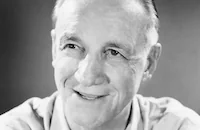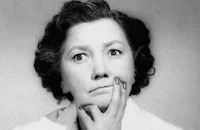The Gorilla

Brief Synopsis
Cast & Crew
Allan Dwan
Jimmy Ritz
Harry Ritz
Al Ritz
Anita Louise
Patsy Kelly
Film Details
Technical Specs

Synopsis
Upon receiving a death threat from the "Gorilla," a crazed murderer, country gentleman and insurance broker Walter Stevens employs detectives Garrity, Harrigan and Mulligan to protect him. The detectives arrive at Stevens' mansion on the appointed night of the murder and proceed to interrogate all present: Kitty, the hysterical maid; Peters, the sinister butler; Stevens' niece, Norma Denby; and her fiancé, Jack Marsden. As the clock strikes midnight, Stevens disappears, and the detectives begin a frantic search for the missing man. The hysteria mounts when the dreaded gorilla is spotted. As the lights flash on and off, Conway, one of Stevens' clients, arrives to accuse Stevens of manufacturing the entire scheme to embezzle his insurance company's funds. Conway's accusation is supported by the appearance of an agent from the Securities and Exchange Commission, who claims that Stevens sent himself his own death threat in order to avert suspicion. To prove his point, the agent leads the detectives through the hidden doorways and catacombs of the mansion, where they find Stevens, who has been bound and gagged. The detectives then discover that the agent is not a member of the SEC, but instead is the murderer known as the "Gorilla." After the detectives restrain the "Gorilla," Stevens admits that he manufactured the death threats and hired an actual gorilla from the circus in order to flush out the real human killer, whose crimes were destroying his insurance business.

Director

Allan Dwan
Cast

Jimmy Ritz

Harry Ritz

Al Ritz

Anita Louise

Patsy Kelly

Lionel Atwill

Bela Lugosi

Joseph Calleia

Edward Norris
Wally Vernon

Paul Harvey
Art Miles
Crew
Harry Joe Brown
David Buttolph
Lewis Creber
Edward Cronjager
Richard Day
Roger Heman
Rian James
George Leverett
Thomas Little
Allen Mcneil
Aaron Rosenberg
Sid Silvers
Gwen Wakeling
Darryl F. Zanuck

Film Details
Technical Specs

Articles
The Gorilla
You would think that a one-set film like The Gorilla could be shot quickly in a matter of days. But this movie had plenty of delays. First, the Ritz Brothers had to postpone filming to attend their father's funeral in early January. The studio, 20th-Century-Fox, responded by leveling a $150,000 lawsuit against the comedy team for violation of contract. When the Ritz Brothers failed to show up for work on January 30th, Fox placed the comedians on suspension, arguing that The Gorilla's screenplay had been written especially for them and if it wasn't produced, the studio would lose a sizable investment. Eventually, the comic trio, despite their low opinion of the project, worked out an agreement with Fox and showed up for work in March. By then, some cast changes had occurred. Kane Richmond, the original romantic male lead, was replaced by Edward Norris and Peter Lorre, cast as the butler, dropped out feigning pneumonia, only to be replaced by Bela Lugosi. Allan Dwan, veteran director of more than 400 features, was brought in to helm The Gorilla and the supporting cast was enhanced by the presence of horror actor Lionel Atwill (Doctor X, 1932) as the wealthy but devious Walter Stevens.
Seen today, The Gorilla is interesting primarily for Lugosi's tongue-in-cheek performance as the butler. He was still in the midst of a successful Hollywood career; the same year he made The Gorilla, he also starred in Ninotchka with Greta Garbo and The Dark Eyes of London (a.k.a. The Human Monster), which featured one of his more interesting horror performances. His decline would begin in the early forties with such no-budget Monogram flicks as Spooks Run Wild (1941) opposite the East Side Kids. As for The Ritz Brothers, their comedy routines are a matter of taste. More successful on the vaudeville and nightclub stage than on film, they often come off like a poor man's version of The Marx Brothers. Patsy Kelly's shrill performance as the terrified maid can also grate on your nerves but ya gotta love a film with two homicidal simians - one, a runaway ape from the circus, the other, a guy in a gorilla suit.
Producer: Harry Joe Brown, Darryl F. Zanuck
Director: Allan Dwan
Screenplay: Rian James, Sid Silvers, based on the play by Ralph Spence
Art Direction: Lewis H. Creber, Richard Day
Cinematography: Edward Cronjager
Film Editing: Allen McNeil
Original Music: David Buttolph
Cast: Jimmy Ritz (Garrity), Harry Ritz (Harrigan), Al Ritz (Mulligan), Anita Louise (Norma Denby), Lionel Atwill (Walter Stevens), Bela Lugosi (Peters), Patsy Kelly (Kitty), Edward Norris (Jack Marsden), Joseph Calleia (Stanger).
BW-67m.
by Jeff Stafford

The Gorilla
Quotes
What's this?- Harrigan
That's a door.- Kitty
Don't you know Poe hates women?- Poe's keeper
So does Kipling.- Kitty
We'll all be murdered in our beds!- Kitty
The Gorilla? HIM? Oh, I'll never trust another man if I live to be a thousand!- Kitty
Peters, what's all that commotion?- Jack Marsden
It sounds like our friends the detectives.- Peters
Trivia
The original play opened in New York on 28 April 1925.
Notes
The opening credits read "The Ritz Brothers in The Gorilla." According to a news item in Hollywood Reporter, the Ritz Brothers walked out of this production over a script conflict, but were persuaded to return. Materials contained in the Twentieth-Century Produced Scripts Collection at the UCLA Theater Arts Library add that Jack Yellen worked with Rian James on a treatment, but his contribution to the final film has not been confirmed. In story conferences, Darryl Zanuck suggested George Zucco, and Samuel Hinds for the role of "Stevens"; Peter Lorre for "Peters"; Lionel Atwill for "Conway"; and William Henry and Kane Richmond for "Jack." First National previously filmed two other versions of the Ralph Spence play: a 1927 film starring Charlie Murray and Fred Kelsey and directed by Alfred Santell; and a 1930 version directed by Bryan Foy and starring Joe Frisco and Harry Gribbon (see AFI Catalog of Feature Films, 1921-30; F2.1999, F2.2200).














